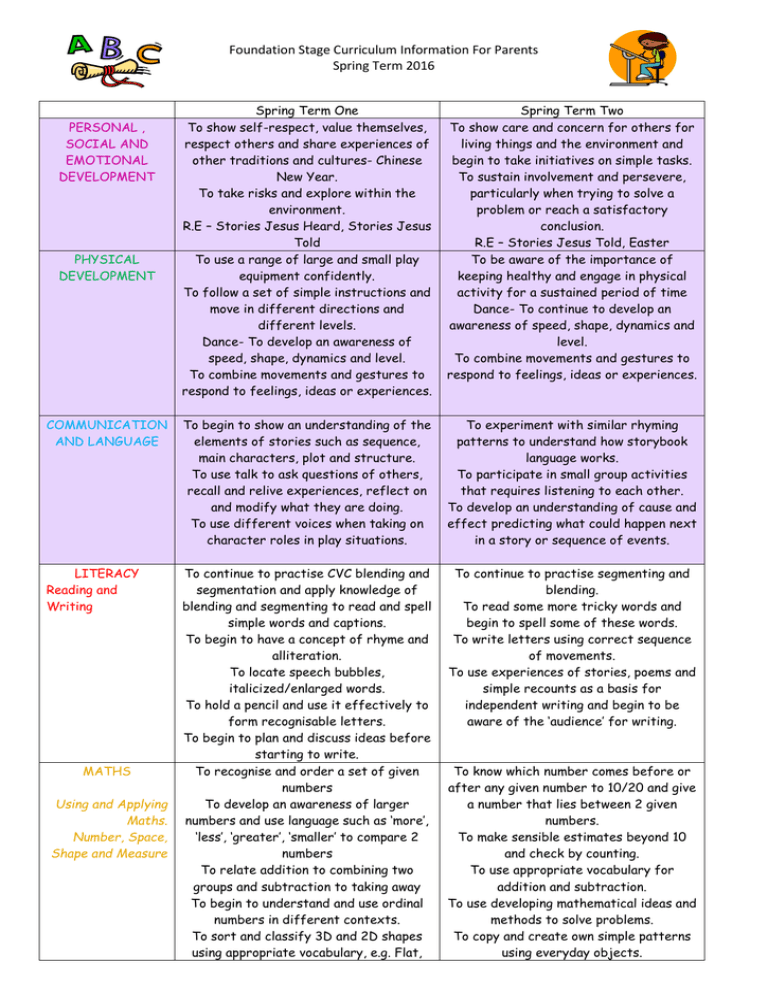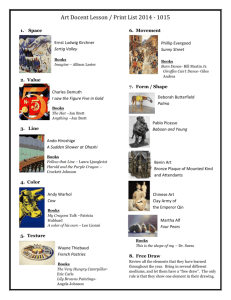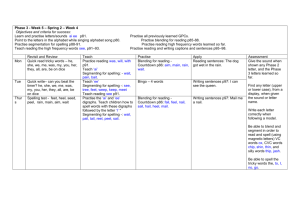Spring Term One
advertisement

Foundation Stage Curriculum Information For Parents Spring Term 2016 Spring Term One To show self-respect, value themselves, respect others and share experiences of other traditions and cultures- Chinese New Year. To take risks and explore within the environment. R.E – Stories Jesus Heard, Stories Jesus Told To use a range of large and small play equipment confidently. To follow a set of simple instructions and move in different directions and different levels. Dance- To develop an awareness of speed, shape, dynamics and level. To combine movements and gestures to respond to feelings, ideas or experiences. Spring Term Two To show care and concern for others for living things and the environment and begin to take initiatives on simple tasks. To sustain involvement and persevere, particularly when trying to solve a problem or reach a satisfactory conclusion. R.E – Stories Jesus Told, Easter To be aware of the importance of keeping healthy and engage in physical activity for a sustained period of time Dance- To continue to develop an awareness of speed, shape, dynamics and level. To combine movements and gestures to respond to feelings, ideas or experiences. COMMUNICATION AND LANGUAGE To begin to show an understanding of the elements of stories such as sequence, main characters, plot and structure. To use talk to ask questions of others, recall and relive experiences, reflect on and modify what they are doing. To use different voices when taking on character roles in play situations. To experiment with similar rhyming patterns to understand how storybook language works. To participate in small group activities that requires listening to each other. To develop an understanding of cause and effect predicting what could happen next in a story or sequence of events. LITERACY Reading and Writing To continue to practise CVC blending and segmentation and apply knowledge of blending and segmenting to read and spell simple words and captions. To begin to have a concept of rhyme and alliteration. To locate speech bubbles, italicized/enlarged words. To hold a pencil and use it effectively to form recognisable letters. To begin to plan and discuss ideas before starting to write. To recognise and order a set of given numbers To develop an awareness of larger numbers and use language such as ‘more’, ‘less’, ‘greater’, ‘smaller’ to compare 2 numbers To relate addition to combining two groups and subtraction to taking away To begin to understand and use ordinal numbers in different contexts. To sort and classify 3D and 2D shapes using appropriate vocabulary, e.g. Flat, To continue to practise segmenting and blending. To read some more tricky words and begin to spell some of these words. To write letters using correct sequence of movements. To use experiences of stories, poems and simple recounts as a basis for independent writing and begin to be aware of the ‘audience’ for writing. PERSONAL , SOCIAL AND EMOTIONAL DEVELOPMENT PHYSICAL DEVELOPMENT MATHS Using and Applying Maths. Number, Space, Shape and Measure To know which number comes before or after any given number to 10/20 and give a number that lies between 2 given numbers. To make sensible estimates beyond 10 and check by counting. To use appropriate vocabulary for addition and subtraction. To use developing mathematical ideas and methods to solve problems. To copy and create own simple patterns using everyday objects. Foundation Stage Curriculum Information For Parents Spring Term 2016 UNDERSTANDING THE WORLD Science, History and Geography. Information and Design Technology EXPRESSIVE ARTS AND DESIGN Art and Music straight, round etc… To talk about, recognise and continue simple patterns. To use appropriate language to compare quantities, use words such as ‘big/ bigger/ biggest, small/smaller/smallest’ To begin to compare and sequence objects according to size-gain an awareness of the need for standard measures To use developing mathematical ideas and methods to solve simple problems. To explore the effects of change to common materials and foods, make comment on change- porridge, ice melting, toast browning etc... . To offer suggestions as to why things happen, solve simple problems and suggest answers to what might happen if…? To gain an awareness of different sources of heat and gain awareness of the benefits/dangers of heat and cold. To gain an awareness of the different types of weather and their effectsSeasonal changes, growth of bulbs etc. To explore stories from different cultures. To investigate a variety of ways of producing sound. To follow instructions to build a model successfully To work with others on a computer to produce a story screen with speech typed into speech bubbles. Music: To identify different sounds and their speeds. To develop awareness of different art forms- painting, sculpture, drawing and examine and respond to the work of a variety of artists. To explore the use of colour in the environment and create own colours. To produce more detailed and representational models. To use resources and props imaginatively to act out a familiar story and describe actions/feelings. To observe and use positional vocabulary, talk about a journey they have made using positional/directional language. To know the days of the week in order and begin to read o’clock time. To use 1p, 2p, 5p, 10p, 20p coins in a roleplay situation and give change To continue to use the computer to develop mathematical concepts To distinguish between living/ non-living things. To be aware of some of the differing requirements of living things - care of pets, different habitats etc…. To show some understanding of the things plants need in order to live and grow, observe growth of spring flowers and show some recognition of the parts of a seedling, plant, flower, tree. To begin to use evidence and analyse information- record sequence of change observed. To identify and name rooms within a house and match furniture according to function. Explore and select materials and equipment. To talk about where I.T has been seen in the home and/or the environment. Music: To distinguish between high and low sounds and respond to them with physical actions. To use an artist’s work as a stimulus for own work. To investigate and explore colour and colour mixing to create a desired effect. To gain an awareness of the beauty of nature and peoples responsibility to care for it. To take on a role and develop it in conjunction with others.





